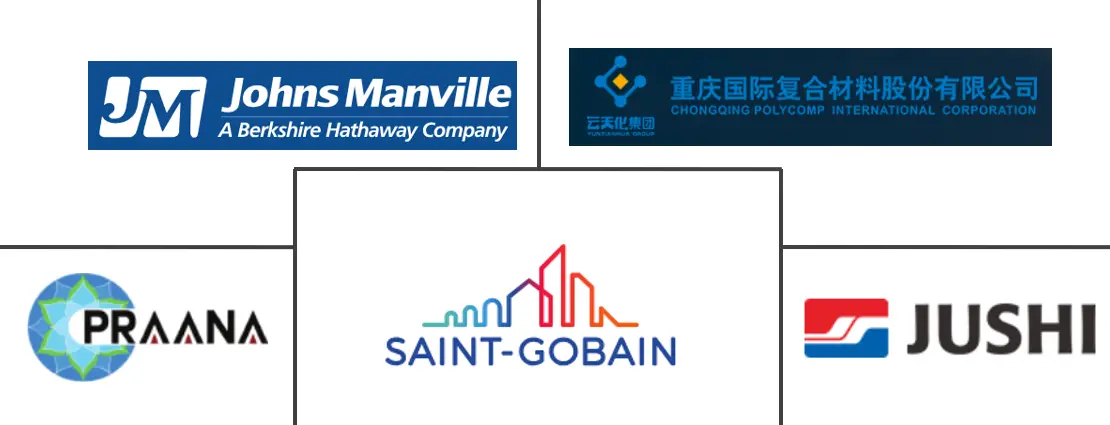Glass Fiber Market Size and Share
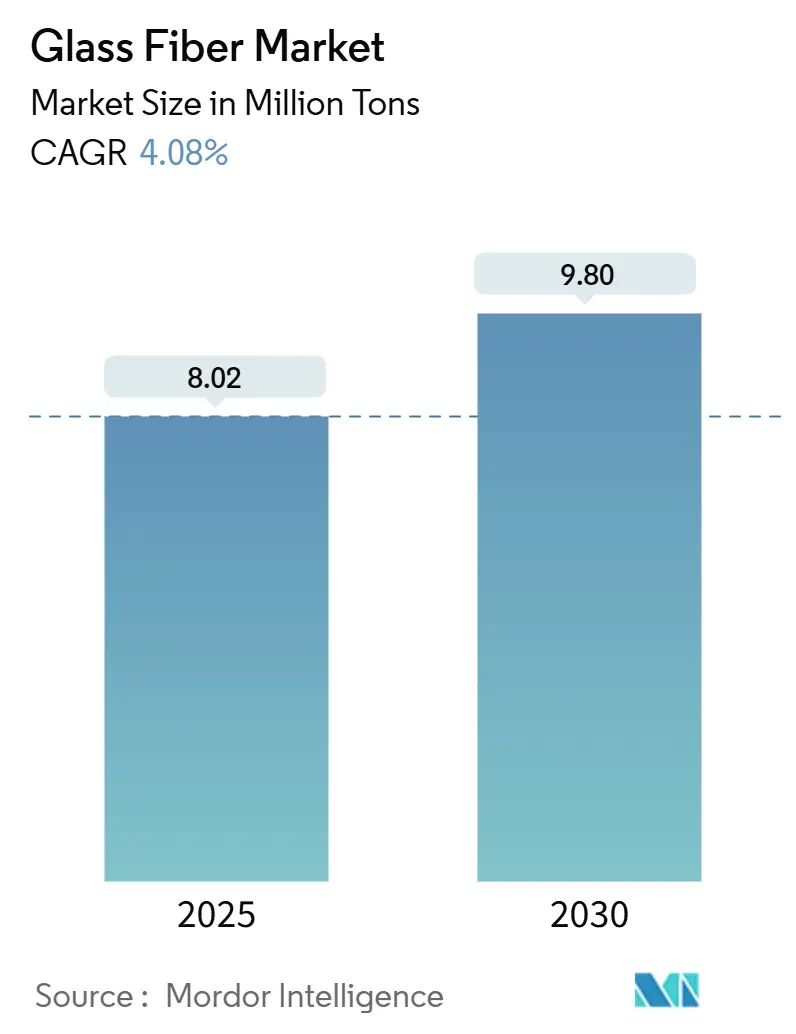
Glass Fiber Market Analysis by Mordor Intelligence
The Glass Fiber Market size is estimated at 8.02 Million tons in 2025, and is expected to reach 9.80 Million tons by 2030, at a CAGR of 4.08% during the forecast period (2025-2030). Demand resilience reflects the material’s combination of tensile strength, corrosion resistance, and cost efficiency, characteristics that continue to displace metals and other legacy materials in infrastructure, mobility, and energy systems. Construction insulation orders recovered quickly after pandemic‐related slowdowns, electric-vehicle (EV) programs accelerated composite uptake in automotive platforms, and wind-energy commitments triggered record blade production. These three demand pillars, together with product innovations such as low-carbon manufacturing lines and closed-loop recycling, are helping producers withstand raw-material cost inflation and trade uncertainties. Capacity rationalization and regional self-sufficiency programs are also reshaping competitive strategies as suppliers position themselves close to end-user growth hubs.
Key Report Takeaways
- By product form, roving led with a 33.84% revenue share in 2024 and is projected to grow at a 4.52% CAGR to 2030, reflecting its foundational role in the glass fiber market.
- By fiber type, E-glass accounted for 49.23% of the glass fiber market share in 2024 and is forecast to expand at a 4.30% CAGR through 2030.
- By end-user industry, construction contributed 33.60% of the glass fiber market size in 2024, and aerospace recorded the highest projected CAGR at 5.55% through 2030.
- By geography, Asia-Pacific held 50.17% of the 2024 volume and is set to rise at a 4.56% CAGR to 2030, underscoring the region’s expanding influence in the glass fiber market.
Global Glass Fiber Market Trends and Insights
Driver Impact Analysis
| Drivers | (~) % Impact on CAGR Forecast | Geographic Relevance | Impact Timeline |
|---|---|---|---|
| Post-pandemic construction boom in Asia drives demand for glass wool insulation | +1.2% | Asia-Pacific core, spill-over to MEA | Medium term (2-4 years) |
| Vehicle-light-weighting pushes chopped-strand composites into EV platforms | +0.8% | Global, with concentration in North America and EU | Long term (≥ 4 years) |
| Wind-turbine blade length growth (>120 m) increases roving consumption | +1.0% | Global offshore markets, APAC manufacturing | Long term (≥ 4 years) |
| Mandatory building-energy codes in EU and NA accelerate retrofit insulation | +0.6% | North America and EU | Short term (≤ 2 years) |
| Hydrogen-pipe projects specify E-CR glass for chemical resistance | +0.4% | EU core, expanding to North America | Long term (≥ 4 years) |
| Source: Mordor Intelligence | |||
Post-Pandemic Construction Acceleration Drives Glass Wool Demand
Asia-Pacific construction spending rebounded strongly in 2024 as governments advanced stimulus pipelines encompassing data-center campuses, semiconductor fabs, and mass-transit networks. These projects specify high-performance insulation to curb operational carbon, placing glass wool on tender lists ahead of lower-R-value substitutes within the glass fiber market. In India, green-building certification is embedded in municipal approval workflows, encouraging developers to select recyclable, flame-resistant insulation. Underground transit corridors highlight glass fiber reinforced polymer (GFRP) rebar because corrosion rates are lower than steel in water-logged environments. Major producers responded with brownfield furnace debottlenecking and new low-carbon melters powered by renewable electricity, actions that shorten lead times to metropolitan construction clusters[1]. Supply tightness has begun to ease as additional capacity ramps up, yet regional demand momentum suggests utilization will remain above 85% through 2026.
Automotive Lightweighting Accelerates Composite Integratio
Battery-electric vehicle programs reward every kilogram saved with measurable range extension, so platform engineers substitute chopped-strand polypropylene and long-fiber thermoplastics in structural brackets, seat frames, and under-hood components. Tier-1 suppliers have commercialized composite leaf springs that cut unsprung mass by 30% while retaining fatigue life, reinforcing demand trends in the glass fiber market. Beyond the skateboard chassis, high-voltage battery enclosures now specify flame-retardant glass fiber/epoxy skins over structural foams, combining thermal shielding with electromagnetic compatibility. Automotive procurement teams also evaluate hybrid lay-ups that place carbon reinforcement only in load-critical zones, offsetting the latter’s higher cost with glass fiber in secondary layers. The resulting material mix strengthens long-term demand visibility for chopped strands, rovings, and multi-end rovings designed for class-A surface finishes.
Wind-Energy Expansion Drives Roving Consumption
Utility-scale turbines installed since 2024 regularly exceed 120 meters in blade length, a change that multiplies glass fiber requirement per unit even as formulation efficiencies improve. Offshore projects dominate additions in Europe, China, and the United States, creating sustained call-offs for direct rovings with improved fatigue resistance. Manufacturers have switched to low-styrene vinyl-ester matrices to facilitate recycling, a shift that in turn forces glass producers to recalibrate sizing chemistry for interfacial bonding. New furnace lines commissioned in coastal industrial parks use on-site wind power to melt batch, cutting scope-2 emissions and qualifying the resulting rovings for low-carbon product labels. The double benefit of energy transition—both as an enabler of renewable capacity and as a beneficiary of decarbonized production—reinforces the glass fiber market’s strategic position in climate policy agendas.
Building-Energy Codes Accelerate Insulation Retrofits
The 2024 update of the International Energy Conservation Code requires continuous insulation over exterior sheathing in multiple climate zones, translating into R-value floors that conventional batts cannot meet alone. Commercial property owners facing higher utility tariffs favor blown glass wool and rigid boards to comply while preserving leasable floor area—an expanding application set within the glass fiber market. In Europe, the recast Energy Performance of Buildings Directive mandates staged performance upgrades at the point of major renovation, stimulating retrofit programs in aging housing stock[2]. Municipalities offer tax credits for verified energy savings, partly offsetting project costs and pulling forward demand. Producers differentiate via high-recycled-content melts that advance circular-economy commitments and achieve points under leading green-building labels.
Restraint Impact Analysis
| Restraints | (~) % Impact on CAGR Forecast | Geographic Relevance | Impact Timeline |
|---|---|---|---|
| Carbon-fiber price erosion squeezes glass-fiber's "value gap" | -0.7% | Global, concentrated in aerospace and automotive | Medium term (2-4 years) |
| Rock-wool makers target <100 kg/m³ density niche in HVAC insulation | -0.3% | North America and EU | Short term (≤ 2 years) |
| Rising soda-ash and energy prices hurt margin in China smelters | -0.5% | Asia-Pacific manufacturing, global supply impact | Short term (≤ 2 years) |
| Source: Mordor Intelligence | |||
Carbon-Fiber Price Competition Pressures Premium Applications
Expansion projects in China, the United States, and the Middle East are doubling global carbon-fiber nameplate capacity between 2023 and 2027. Economies of scale, lower-cost polyacrylonitrile precursors, and automation have already trimmed average prices by more than 15% compared with 2022 levels. As cost curves fall, automotive and aerospace engineers revisit material selection for selective structural parts, intensifying competitive pressures within the glass fiber market. Hybrid fabrics that alternate carbon and glass to balance stiffness and impact resistance further cannibalize glass volumes at the top of the performance pyramid. Glass fiber producers counteract by developing higher-modulus S-glass and corrosion-resistant E-CR formulations, though these upgrades narrow, rather than eliminate, the price gap to carbon. Unless carbon pricing or recycling credits favor glass, the premium application share may drift toward carbon-rich laminates over the next product cycle.
Raw-Material Cost Inflation Pressures Manufacturing Margins
Bulk energy tariffs followed a similar trajectory as grid operators passed through higher liquefied-natural-gas imports. Because soda ash and energy together account for more than 50% of glass fiber variable costs, margin recovery lags selling-price adjustments in contract-dominated channels, creating operational headwinds in the glass fiber market. Some mills substituted cullet for virgin batch, reducing melt temperature by nearly 100 °C and saving up to 8% in electricity per ton of fiber. Others invested in photovoltaic arrays and oxygen-enriched combustion to hedge future fuel volatility. Short-term pain may accelerate consolidation as smaller, less efficient plants struggle to finance furnace rebuilds under tightened environmental permits.
Segment Analysis
By Product Form: Roving Supports Next-Generation Blades and Automotive Structures
Rovings anchored 33.84% of 2024 demand and remain the fastest-expanding product form. Their linear-strand architecture delivers the unidirectional strength essential for 100-meter-plus turbine skins, a use case that alone accounts for a third of global roving shipments. The glass fiber market size attributed to roving is forecast to grow 4.52% annually as offshore installations escalate and as automotive over-molded composites gain scale in leaf springs, seat backs, and battery frames. Process upgrades such as inline cake cutting and advanced sizing formulations improve wet-out and reduce void content, enabling higher throughput in pultrusion and filament winding.
Producers are also trialing virtual sensors on winder stations, transmitting data to cloud-based quality modules that cut waste and document carbon footprints—digital upgrades increasingly relevant across the glass fiber market. Mats occupy the second-largest slot, favored for spray-up boat hulls and roofing membranes where conformability outweighs directional strength. Strands and yarns cater to PCB laminates, filtration, and 5G radome fabrics, niches that demand tight diameter tolerance and minimal shot content.
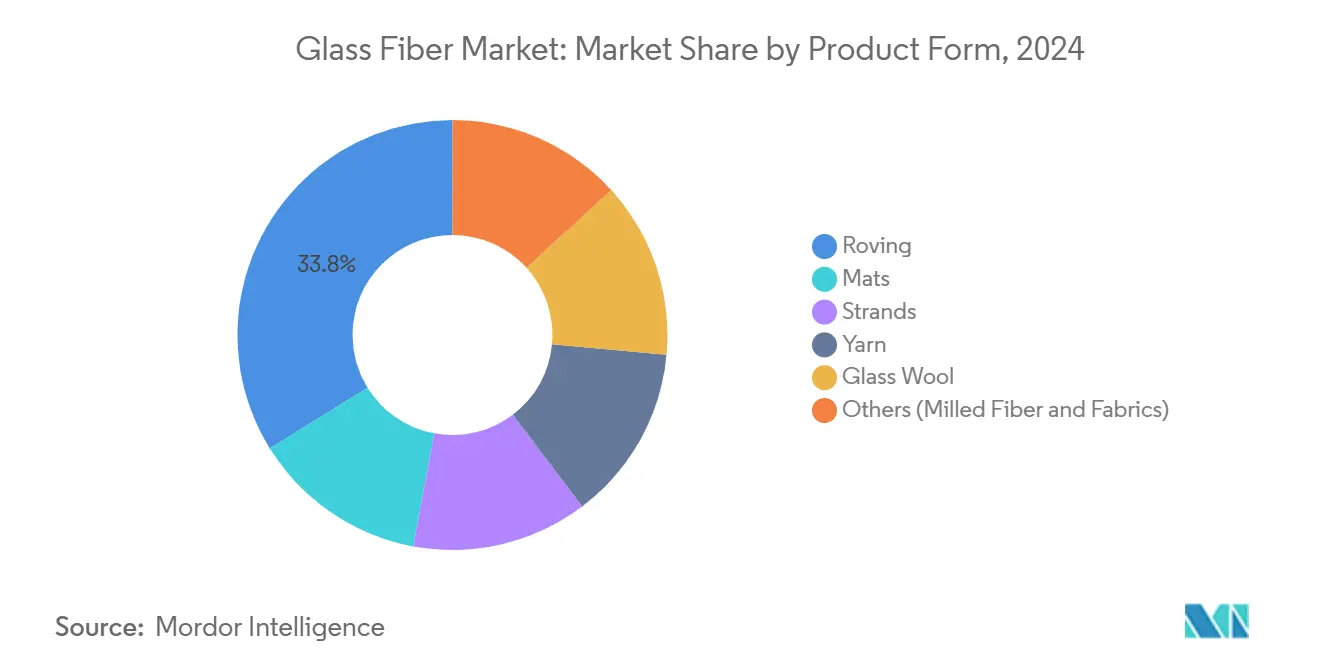
Note: Segment shares of all individual segments available upon report purchase
By Fiber Type: E-Glass Balances Performance and Cost
E--glass maintained 49.23% of 2024 volume on the strength of its modulus-to-price ratio and its process versatility across thermoset and thermoplastic matrices. Continuous incremental tweaks, such as optimized alumina content for higher softening points and new silane-based sizings that improve interface shear strength, keep the grade relevant even as performance requirements rise. The sub-segment’s contribution to the glass fiber market share is helped by its availability from all major regions, reducing lead-time risk for multilocation OEMs.
S-glass, with its higher tensile modulus, captures airframe stringers, rotorcraft blades, and ballistic armor panels where every gram saved counts. Growth into hydrogen pressure vessels is also visible as pipeline pilot projects scale, further expanding high-performance niches in the glass fiber market. E-CR formulations target chemical processing, desalination, and flue-gas stacks, where corrosive media degrade conventional E-glass in service.
By End-User Industry: Construction Leads, Aerospace Accelerates
Building and construction absorbed 33.60% of 2024 output as infrastructure megaprojects, urban housing starts and energy-efficiency retrofits converged. Glass fiber reinforced polymer rebars are displacing steel in coastal bridges and subway stations, cutting life-cycle repair costs tied to chloride-induced corrosion. Glass wool blankets and boards remain default choices in partition walls and roofing; adoption is further reinforced by energy codes mandating higher insulation values. The construction-linked glass fiber market size is expected to track mid-single-digit growth even as stimulus funding normalizes, supported by mandatory energy-performance ratings at the point of sale or lease in major economies.
Automotive is propelled by the shift from internal-combustion engines to heavier battery packs that need structural weight compensation elsewhere. Average glass fiber loading per vehicle rose in 2025 as composite seat frames, instrument panels, and under-body shields hit serial production. Although smaller, Aerospace and defense registers a 5.55% CAGR as more single-aisle aircraft enter fleets and regional air-mobility prototypes embrace all-composite fuselages. Marine and wind energy account for steady baseline demand; both segments value glass for its saltwater corrosion resistance and predictable fatigue behavior. Electronics, sports and leisure serve as high-margin outlets for specialty fibers tailored to dielectric performance or aesthetic finishes. Structural battery casings and hydrogen composite pipes represent emerging applications that could recalibrate the end-user hierarchy later in the decade.
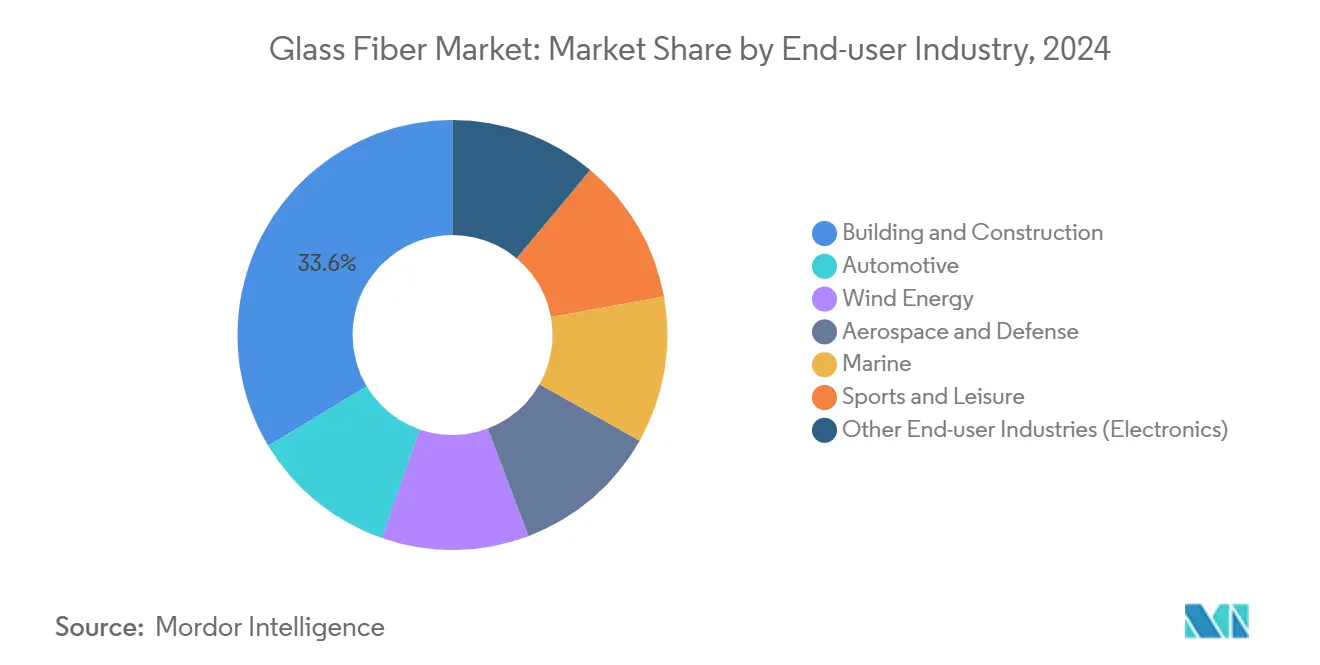
Note: Segment shares of all individual segments available upon report purchase
Geography Analysis
Asia-Pacific dominated with 50.17% of 2024 shipments and is projected to retain leadership through 2030 at a 4.56% CAGR. National industrial policies encourage domestic sourcing of turbine blades, EV parts, and high-speed rail components, effectively locking in local suppliers across the glass fiber market. China invests in carbon-neutral furnaces powered by captive wind farms, an initiative that lowers embedded emissions and qualifies exports for low-carbon product categories.
North America’s market is growing wth building-energy codes and EV platform launches offsetting slower oil-and-gas composite pipe demand. Expanded solar and wind tax credits amplify the replacement cycle for turbine blades, a trend that benefits mid-continent roving plants. Recycled content mandates in select U.S. states encourage the use of cullet, supporting scrap markets and reducing dependence on imported soda ash. Europe’s outlook hinges on offshore wind build-outs in the North Sea and Baltic, but trade defense measures under investigation may reshape supply chains should tariffs on Asian rovings intensify.
Glass fiber reinforced pressure vessels could see early adoption in green-hydrogen corridors linking the Gulf to Europe. Latin America’s modest baseline is anchored by Brazilian wind parks and Mexico’s automotive assembly plants, both of which are ramping post-pandemic. Regional producers may struggle with feedstock import costs; nonetheless, free-trade agreements and nearshoring initiatives draw investment aimed at shortening trans-Pacific freight legs.
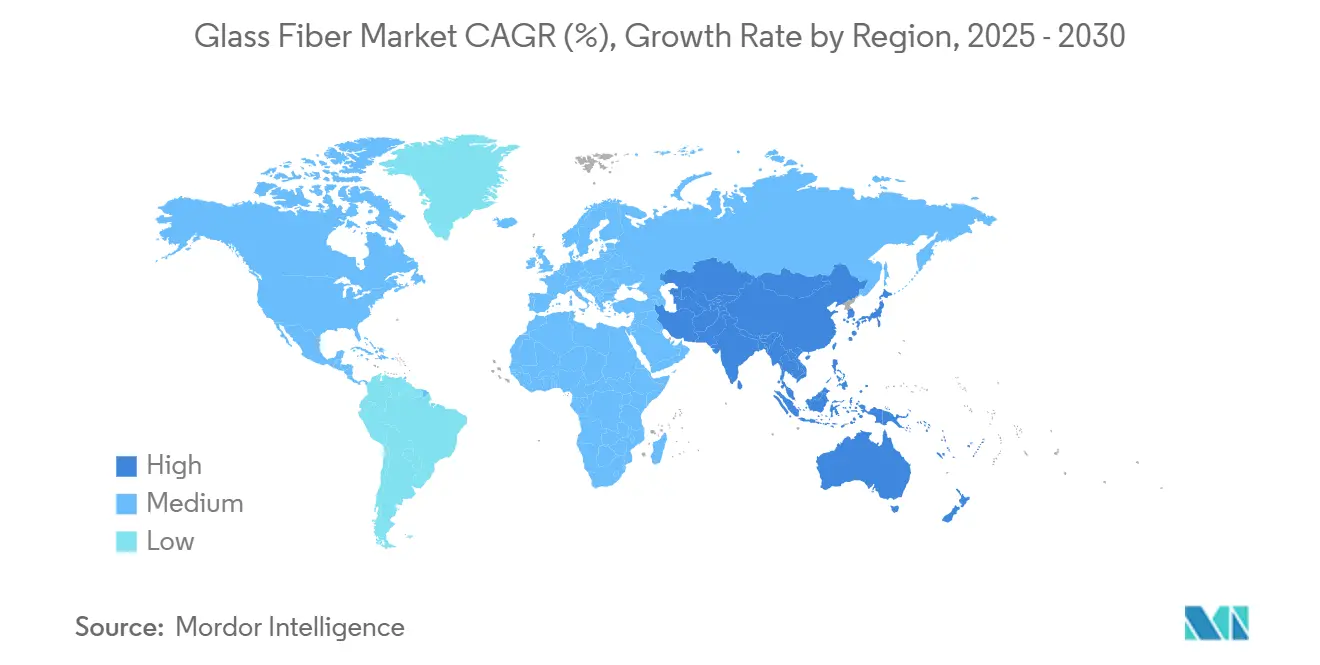
Competitive Landscape
The market is moderately fragmented. Trade policy remains the wild card. European anti-dumping probes into Chinese rovings coincide with U.S. tariff rate reviews on composite inputs, prompting Tier-1 molders to diversify sourcing. Producers answer by localizing finishing lines closer to customers, a move that trims logistics costs and shields clients from duty risk. Innovation differentiators now include bio-based sizings, closed-loop recycling, and product-carbon-footprint audits verified by third parties. Small and mid-size players unable to fund furnace modernization face margin compression from soda-ash inflation and could become targets for roll-up strategies. On the customer side, automotive and wind OEMs increasingly negotiate multi-year offtake contracts indexed to energy prices, locking in supply while sharing input-cost risk.
Glass Fiber Industry Leaders
-
Johns Manville
-
China Jushi Co., Ltd.
-
Chongqing International Composite Materials Co., Ltd.
-
Praana Group
-
Saint-Gobain
- *Disclaimer: Major Players sorted in no particular order
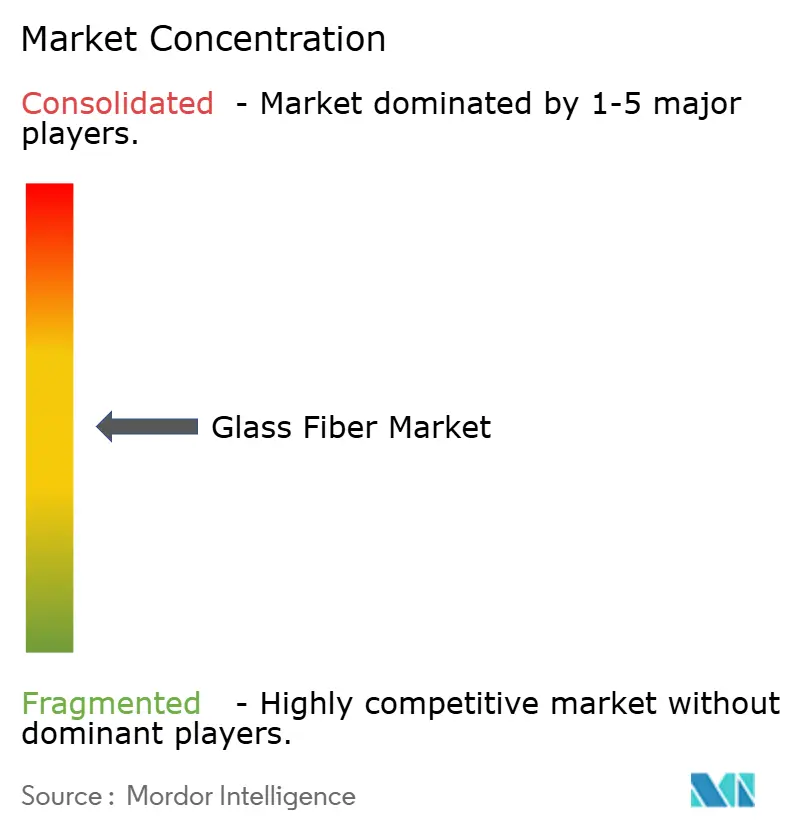


Recent Industry Developments
- February 2025: Owens Corning completed the USD 755 million sale of its global glass-reinforcements business to Praana Group, refocusing on building-products growth.
- July 2024: China Jushi inaugurated a second line at its Huai’an carbon-neutral base, powered by on-site wind turbines that cut annual emissions by more than 400,000 tons.
Global Glass Fiber Market Report Scope
Glass fiber, also known as fiberglass, is a material composed of extremely fine glass fibers. These fibers can be woven into a fabric or used as a reinforcing material in composite materials. Glass fibers are known for their high strength, lightweight, and corrosion resistance properties, making them suitable for a wide range of applications across industries such as construction, automotive, aerospace, marine, electronics, and telecommunications. They are commonly used in insulation, composites, reinforcement materials, and optical fibers.
The glass fiber market is segmented by type, application, end-user industry, and geography. On the basis of type, the market is segmented into chopped strands, glass wool, roving, and yarn. On the basis of application, the market is segmented into composites and insulation. On the basis of the end-user industry, the market is segmented into building and construction, automotive, aerospace and defense, alternative energy, consumer goods, industrial, and other end-user industries (electronics). The report also covers the market size and forecasts for the glass fiber market in 15 countries across major regions. For each segment, the market sizing and forecast have been done on the basis of value (USD).
| Roving |
| Mats |
| Strands |
| Yarn |
| Glass Wool |
| Others (Milled Fiber and Fabrics) |
| E-Glass |
| S-Glass |
| E-CR Glass |
| C-Glass |
| Others |
| Building and Construction |
| Automotive |
| Wind Energy |
| Aerospace and Defense |
| Marine |
| Sports and Leisure |
| Other End-user Industries (Electronics) |
| Asia-Pacific | China |
| India | |
| Japan | |
| South Korea | |
| Indonesia | |
| Vietnam | |
| Malaysia | |
| Thailand | |
| Rest of Asia-Pacific | |
| North America | United States |
| Canada | |
| Mexico | |
| Europe | Germany |
| France | |
| United Kingdom | |
| Italy | |
| Spain | |
| Russia | |
| Turkey | |
| Nordics | |
| Rest of Europe | |
| South America | Brazil |
| Argentina | |
| Colombia | |
| Rest of South America | |
| Middle-East and Africa | Saudi Arabia |
| United Arab Emirates | |
| Qatar | |
| Egypt | |
| South Africa | |
| Nigeria | |
| Rest of Middle-East and Africa |
| By Product Form | Roving | |
| Mats | ||
| Strands | ||
| Yarn | ||
| Glass Wool | ||
| Others (Milled Fiber and Fabrics) | ||
| By Fiber Type | E-Glass | |
| S-Glass | ||
| E-CR Glass | ||
| C-Glass | ||
| Others | ||
| By End-user Industry | Building and Construction | |
| Automotive | ||
| Wind Energy | ||
| Aerospace and Defense | ||
| Marine | ||
| Sports and Leisure | ||
| Other End-user Industries (Electronics) | ||
| By Geography | Asia-Pacific | China |
| India | ||
| Japan | ||
| South Korea | ||
| Indonesia | ||
| Vietnam | ||
| Malaysia | ||
| Thailand | ||
| Rest of Asia-Pacific | ||
| North America | United States | |
| Canada | ||
| Mexico | ||
| Europe | Germany | |
| France | ||
| United Kingdom | ||
| Italy | ||
| Spain | ||
| Russia | ||
| Turkey | ||
| Nordics | ||
| Rest of Europe | ||
| South America | Brazil | |
| Argentina | ||
| Colombia | ||
| Rest of South America | ||
| Middle-East and Africa | Saudi Arabia | |
| United Arab Emirates | ||
| Qatar | ||
| Egypt | ||
| South Africa | ||
| Nigeria | ||
| Rest of Middle-East and Africa | ||


Key Questions Answered in the Report
How large is the glass fiber market in 2025?
The glass fiber market size is 8.02 million tons in 2025, with a forecast to reach 9.80 million tons by 2030 at a 4.08% CAGR.
Which region consumes the most glass fiber?
Asia-Pacific leads with 50.17% of global volume in 2024 and is also the fastest-growing region at a 4.56% CAGR.
Why is roving in high demand?
Longer wind-turbine blades and lightweight automotive structures rely on roving for unidirectional strength, making it the largest and fastest-growing product form.
What is driving glass fiber use in construction?
Stricter building-energy codes and green-building certifications favor high-R-value, fire-resistant glass wool insulation and corrosion-proof GFRP rebars.
How are producers responding to raw-material inflation?
Manufacturers are increasing recycled cullet use, investing in renewable-powered furnaces and localizing production to mitigate soda-ash and energy cost spikes.
Page last updated on:
